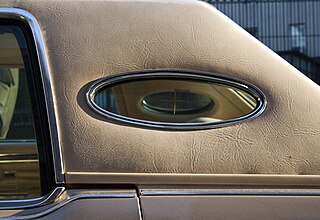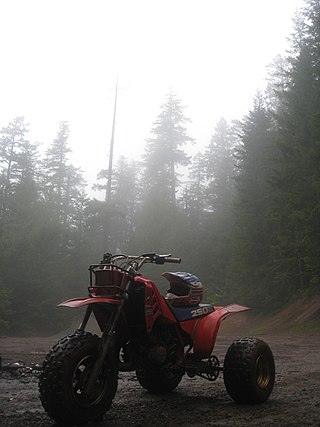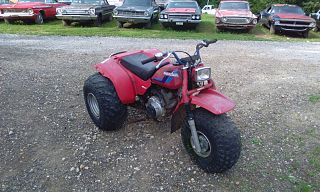The year 1983 in television involved some significant events.

An all-terrain vehicle (ATV), also known as a light utility vehicle (LUV), a quad bike or quad, as defined by the American National Standards Institute (ANSI), is a vehicle that travels on low-pressure tires, has a seat that is straddled by the operator, and has handlebars. As the name implies, it is designed to handle a wider variety of terrain than most other vehicles. It is street-legal in some countries, but not in most states, territories and provinces of Australia, the United States, and Canada.

The Ford LTD is a range of automobiles manufactured by Ford Motor Company for the 1965 to 1986 model years. Introduced as the highest trim level of the full-size Ford model range, then the Galaxie, the LTD offered options and features that had previously been reserved for more luxurious Lincoln and Mercury models. The largest vehicle produced by Ford in North America for most of its production, the LTD was joined by the intermediate Ford LTD II from 1977 to 1979; the LTD II served as the replacement for the Torino/Gran Torino range. At various times throughout its production, the LTD range included two- and four-door pillared and hardtop sedans, a two-door convertible, and the Country Squire five-door woodgrain station wagon.
The Honda CR series was a line of off-road motorcycles made by the Honda corporation from 1973 to 2007. They are the two-stroke Honda racing motorcycles with countless trophies in the 125, 250 and 500 motocross classes. Marty Smith, Jeremy McGrath, Ricky Carmichael and many other motocross legends dominated racing circuits on Honda CRs. CRs continue competing today and are prized by racing enthusiasts and collectors alike.

Charles Edward Whittingham was an American Thoroughbred race horse trainer who is one of the most acclaimed trainers in U.S. racing history.

An opera window is a small fixed window usually behind the rear side window of an automobile. They are typically mounted in the C-pillar of some cars. The design feature was popular during the 1970s and early 1980s and adopted by domestic U.S. manufacturers, most often with a vinyl roof.

The ATC250R is a high-performance, three-wheeled ATV produced by Honda from 1981 to 1986. Cited as the first high performance ATC introduced, production began with an air-cooled, 248 cc single-cylinder two-stroke engine, but would see a liquid-cooled, 246 cc engine by 1985. All model years were fully suspended and adjustable, using air-assisted front forks and a single, remote reservoir gas-charged rear shock. 1981–1982 models offered 6.7 inches of front suspension travel and 4.3 inches in the rear, 1983–1984 offered 8.7 inches in front and 8.1 inches rear, while post-1985 Models allowed 9.8 inches of travel. All model years also used a gear-driven counter-balancer to reduce engine vibration. Dual disc brakes were used on all model years, with the exception of the 1981, which used a front disc and a rear drum.
The cars in Miami Vice mainly involve the Ferrari Daytona Spyder and the Ferrari Testarossa, but also include other automobiles driven by the characters on the show. Currently one Daytona is in a private collection and the other is on display at the Volo Auto Museum; the Ferrari Testarossa stunt car resides in Kingsport, Tennessee and is owned by Carl Roberts of Carl Roberts Motor Group. Today, one of the hero cars is part of The Witvoet collection owned by Bastiaan Witvoet in Belgium.
This is a list of automobiles produced for the general public in the North American market. They are listed in chronological order from when each model began its model year. If a model did not have continuous production, it is listed again on the model year production resumed. Concept cars and submodels are not listed unless they are themselves notable.
Honda US90, ATC90 and ATC110 directed here

The Honda ATC200 is an all-terrain vehicle that was introduced in 1981 as Honda's top model in the ATC line-up, remaining, in various forms, until Honda voluntarily ceased production in 1987. In the six years of production, six variations were made, often sold concurrently. Collectively, Honda produced over 530,000 ATC200 vehicles, becoming the most prolific sellers in the ATC market, and one of the most recognizable ATCs available.
Honda Sport ATCs, produced until 1987, were built specifically for performance, and designed for use in racing, or for aggressive trail riding. The machines lacked luggage racks and other utilitarian features, commonplace on most other ATCs or ATVs.
The Honda ATC125M was a three-wheeled All Terrain Cycle released in 1984, and received a major revision in 1986. The model was sold through 1987, when Honda voluntarily discontinued sales of ATC's. The first iteration can trace its development back to Honda's first ATC, the Honda US90, released in 1970, while the second iteration borrowed heavily from the ATC200 line.





